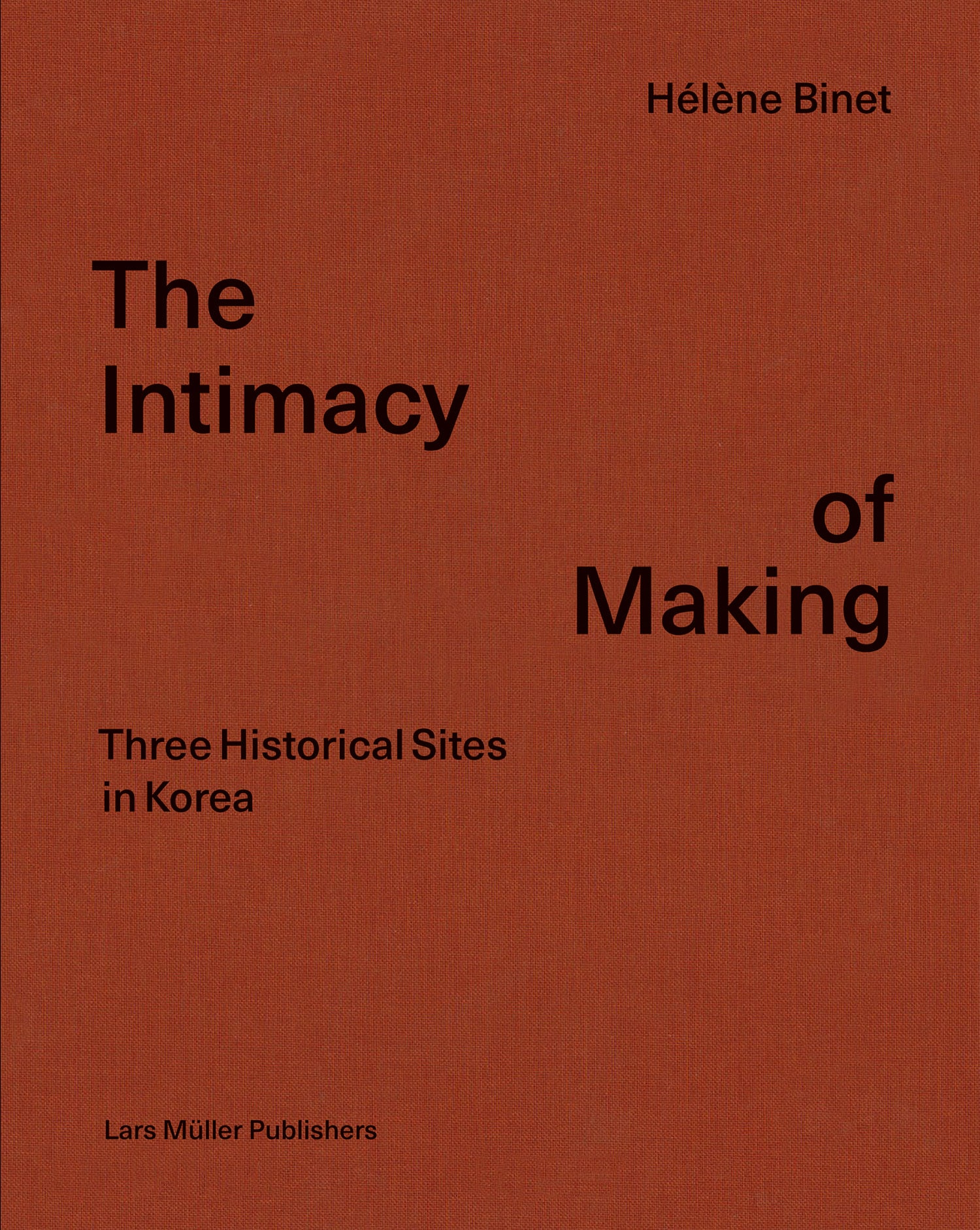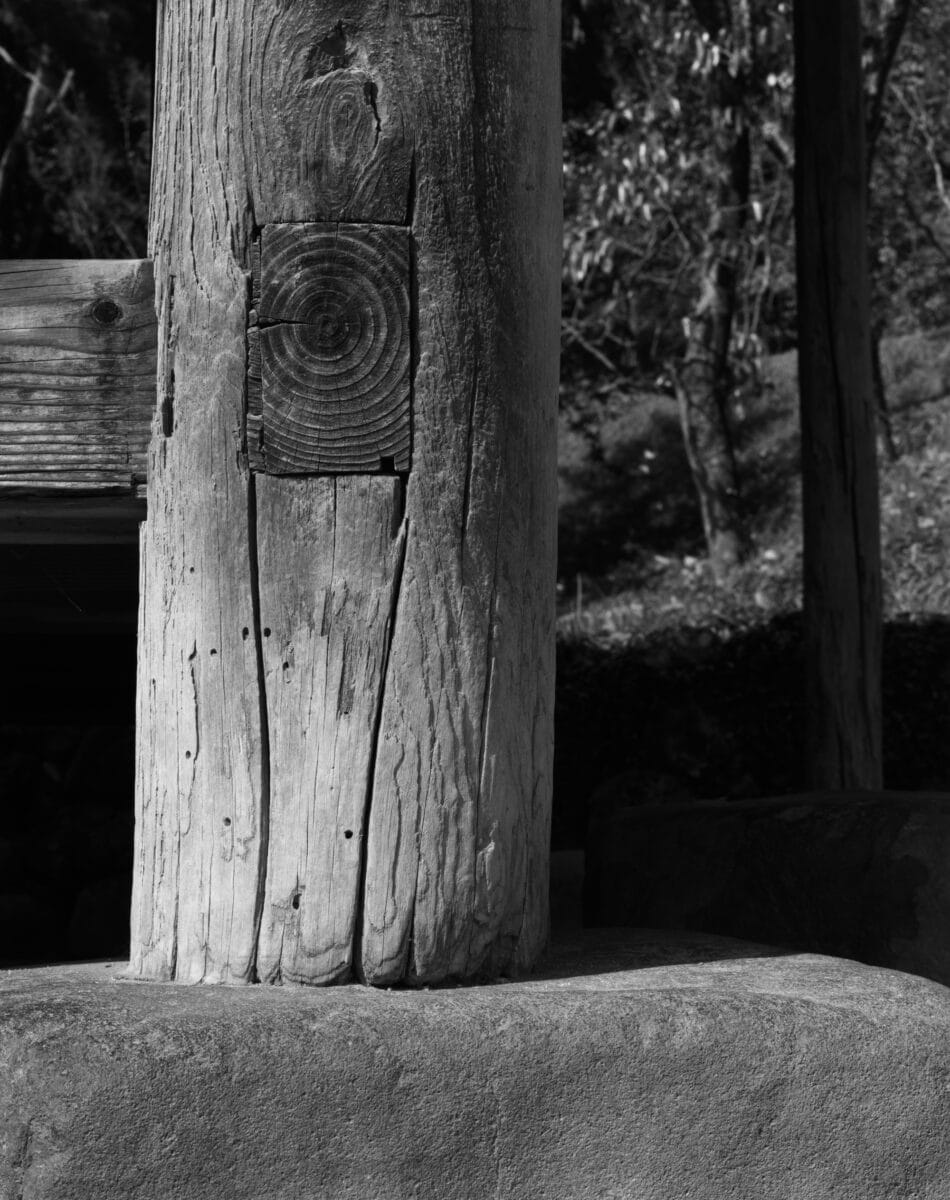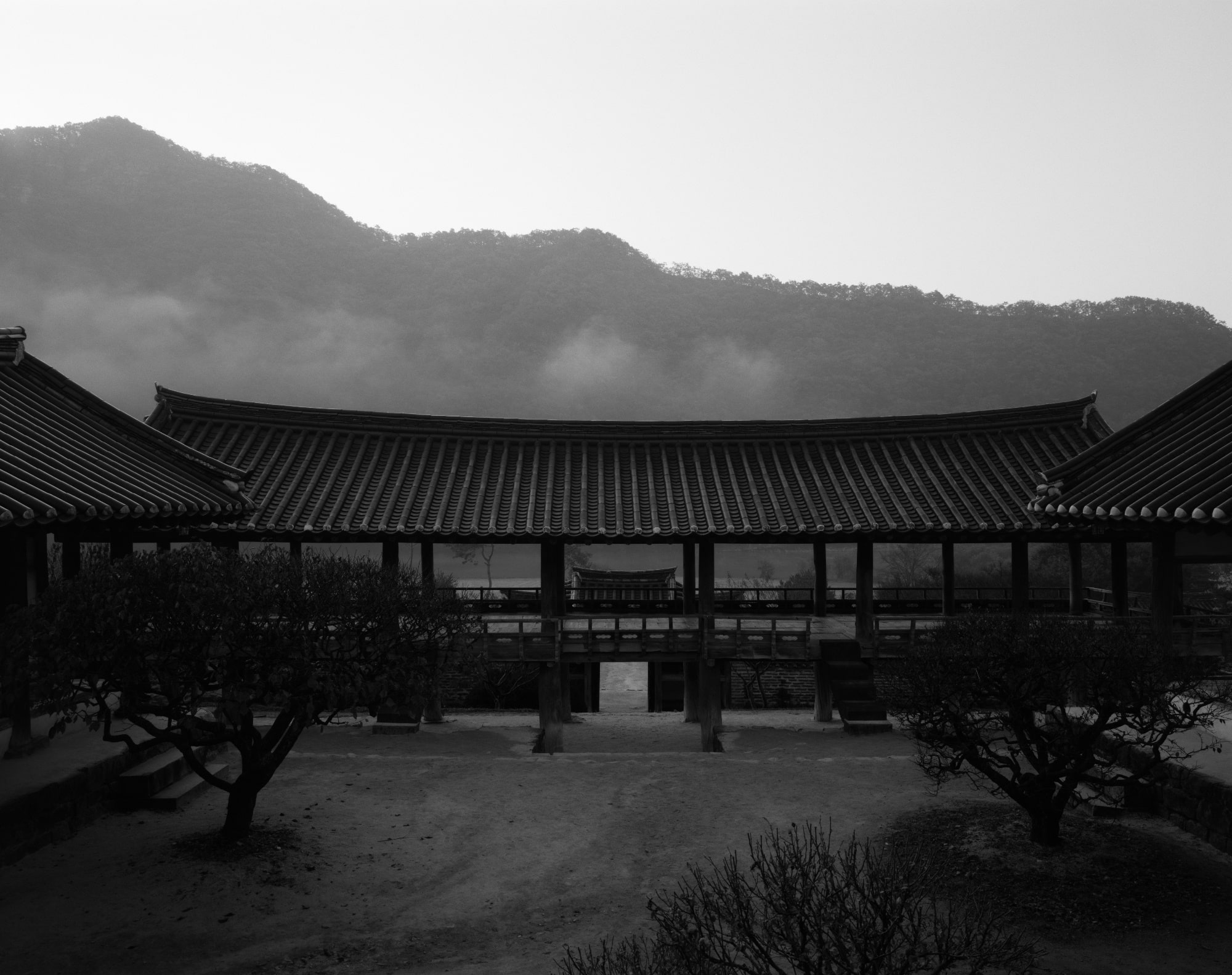Hélène Binet: The Intimacy of Making, Three Historical Sites in Korea (2021): Review

What is a myth, today? I shall give at the outset a first, very simple answer, which is perfectly consistent with etymology: myth is a type of speech.
– Roland Barthes, Mythologies, 1957
This seemingly simple book is a thought-provoking collection of things. There is a lot of room for implication and suggestion in the (c150) photographs by Hélène Binet, in the space between them and between them and the three essays, each telling a different story. Vague concepts that often crop up in writing and talking about architecture parry below the surface. Perhaps this is one of the powers of photography: to capture preconceptions and hold them still long enough to be prodded a little.
Although he doesn’t explicitly use the phrase, Byoung Soo Cho in his essay ‘Mahk and Bium: Imperfection and Emptiness in Korean Architecture’ employs these two ideas, roughly translated in the essay’s title, to suggest that a pervasive timelessness is inherent in the book’s subjects – three historical sites in Korea, and in Binet’s mostly black and white photographs of them. Two date from the sixteenth century: the landscaped hillside at Soswaewon belonged to a scholar and remains a garden located in a secluded, wooded valley; and Byeongsan Seowon is a remote Confucian school. The oldest, the Jongmyo Shrine, dates from the late thirteenth century.

Cho describes a ‘rain-worn wooden beam and the stone that has supported it, unmoving for five hundred years’ referring, perhaps, to this photograph (above), which shows a joint between a timber beam and a timber column that stands directly on a stone base. Confronted with this representation of a far-away reality, we ask what it means – even, what can I take away from the experience of looking at this seemingly banal situation? What is it that I am supposed to see?
The subject – the column, beam and base together making a joint in the structure – has its own history. As an ensemble they have stood there ‘unmoving for five hundred years’, rain washing over them, wind blowing around them. The scholar himself and visitors who came after maybe stubbed their toes against them countless times. At some point in the past, insects have burrowed into the wood, but they are no longer there. The conceptual freight, the signification of the image depicting them that empties out this specific history, depends on who you are; on the things you know and where you are looking from. To guide the reader towards an opinion, however, both Cho’s essay and Eugénie Shinkle’s text ‘A Slow Unfolding of Space: The Photographs of Hélène Binet’, which supplies a useful synoptic argument about the relationship between architecture and photography, suggest possible readings around the seemingly timeless character of the sites and these photographs of them.
During the five hundred years that this timber structure with its stone base has endured, supposedly unchanging and intact, the human world has swirled around it. The word that gives Cho away is authenticity: ‘Korean architecture is above all guided by the hyper-efficient usage of space and material and a disinterest in pretension or even in insufficiently complete authenticity,’ he writes. If the timber joint represents authentic Korean architecture, we could call it a vernacular; what could be the inauthenticity that is its other? Cho points out that: ‘In the 1930s and 1940s, under Japanese settler colonisation, even the Korean language itself was banned from all public life. In the decades that followed, Westernisation and Christianity swept the nation, and many traditional Korean practices were further buried and shunned in favour of modernisation. Thus, much of the true spirit of Korean creativity has, for some time, been in decline.’ The banal joint that is still there can represent, therefore, the authentically Korean. Shinkle, too, finds distance from authenticity in the modern, for her it is not connected to the estrangement of colonialisation but to a more generic modernist alienation.

This photograph shows the shadow of a bush cast upon a dusty ground, at one edge it creeps over a stony step towards the deepening shade of a building’s interior. It could be a study of the little tree’s character. On the other hand, it could be signifying timelessness via a different strategy, through an implication of cyclical time – of days, years, seasons – in its shadows and leafiness that contrast with the tidy ground and dust-free floors. These manifestations of the ‘natural world’ are intensified by the overlaying of other ‘natural’ phenomena that seem timeless but which, as we are increasingly aware, belong to the Anthropocene – the weather, the geographical prevalence of specific trees and plants, the relentless tread of pilgrims and tourists.
Both Cho and Shinkle interpret Binet’s photographs and explain her intentions through the perspectives of their texts many times over, often illustrating the argument with a loose observation: ‘For Hélène Binet, a building is more than a concept of an inanimate form – it is a rich, complex world with a soul and a voice,’ says Shinkle. Her work is an invitation to reflect ‘on the subtle but vital distinction between the cultural value of a photograph, and that of the place it depicts.’ Cho’s approach is similar in its vague punctuation: ‘I believe that the true spirit of mahk and bium manifest themselves in a gentle and humble spirit in Korean creative traditions … humanness itself, in its most unpolluted state,” he writes, continuing with the opinion that ‘Binet’s work exposes her deep lucidity and appreciation for these qualities, and even more so, exemplifies mahk and bium in and of themselves, and in doing so, magnifies these facets of her subjects with beautiful honesty.’ Binet, in her own short essay at the end called ‘Observations’, does not contradict this statement, but she does throw a different spin on the book’s title ‘The Intimacy of Making’.
My aim with photography has always been to achieve directness, rawness and simplicity with a strong emphasis on the pleasure and intimacy of making. While discovering the Korean historical architecture, I encountered the same attributes and I felt as if I were meeting an ancestor who has always been there, guiding my observations and craft.
The personal mythology that she is setting down, involved with the intimacy of making a photograph, is described through very specific moments experienced at these places. These occur near the beginning of a process that starts with arriving and ends in the darkroom, or even, in the potential of a book as ‘another space that can be run through with the eye.’ Of her time at Soswaewon, for example, she says ‘As I was sitting on a stone before the work started, my thoughts were already transported by a tree with seductive branches by a wall of infinite bamboo or small and witty bushes.’

This is a photograph of an exterior space bounded by three permeable, pitched-roofed structures that fill the ground before a range of wooded hills. Casting aside the inherent history of this site that the viewer cannot know, what could be the meaning of this image of a mysterious dark place that more than anything is a space from a dream, where every element seems motivated by an individual will?
In pursuit of ways to understand these photographs by Binet, and to see how they could coalesce in their representation, signification and presence into alternative myths, I asked Jaehee Shin, a young Korean architect of my acquaintance, for her opinion. She had grown up in a place like these, and received part of her architectural education in Korea, and then in Europe. This is what she wrote to me at first:
I was actually very surprised to see Hélène’s photo. Because it was a completely different interpretation from how we usually look at these historical architecture spaces. I think that the created object has an important meaning, but how to view and interpret it is another artistic method.
A few days later, in reply to my question, ‘is there a short answer to how you see these historical architectural spaces?’ she sent me the following analogy:
Yesterday I visited a bookstore and looked at Hélène’s photo book again. When I first looked at this book, my first impression was that places that I knew well had been read differently.
Have you ever eaten bibimbap? Or it’s like Japchae or Kimbap.
The interesting thing about Korean cuisine is that it doesn’t matter what exact and special ingredients there are. When you open the refrigerator, you cut the ingredients in a similar way, just what you have, and cook them in a very simple and short way with a little salt, pepper and sesame oil in a frying pan, but separately. You will mix each ingredient with such as gochujang and sesame oil. Because they are not cooked together, the ingredients have their own flavour and at the same time, those different tastes are mixed well due to the gochujang or sesame oil.
Gidan (the foundation of Korean traditional architecture) is a very important element in Korean architecture, and I think Hélène captured this point well. The way stones and trees meet together is so interesting, it is almost like a natural resource.
The first impression as a Korean when I visited these historical places was that it is visually very important where this is built and how this is laid out. They harmonise all together.
In fact, for Bibimbab it is a very simple cooking method, but it takes a lot of work and care. This is because you don’t put everything in the oven or pot all at once. Because the essence is the whole… the important thing is that each individual ingredient in Bibimbab can always have their original taste. When I visited this place, it was more about looking at the whole thing together not at the details. Because the whole thing is harmonised.
So, when I saw this picture, I was surprised, this was a new perspective. Because it’s a way of looking at parts in detail. And she found through observation our way of making. It may be very tolerant and not precise compared to western culture but it can be very harmonised.
‘selling tradition gives birth to a new tradition’
– Myeung Hee Park, 2012 (House: orchestration of time and space)
The Intimacy of Making, Three Historical Sites in Korea (2021) by Hélène Binet is published by Lars Müller Publishers. Copies of the publication can be purchased here.
Helen Thomas is Reviews Editor at Drawing Matter.
